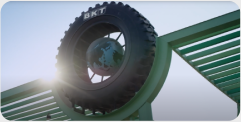Are you sure you know how to read your tires? Do you really know all about the several symbols stamped on the sidewall? Find out with our training!
Over the last weeks, we have spoken about Off-Highway tire marking and how the size is written differently depending on the tire type. Are you sure you know how to read your tires? Do you really know all about the several symbols stamped on the sidewall? Find out with our training!
The first reference the code gives is the section width. This means the tire width without the prominences due to tire marking. The measure can be in millimeters or inches depending on the manufacturer’s origin and policy.
The code also provides information on the section height, which is shown in the marking through the aspect ratio and expressed as a percentage of the tire width. For instance, 710/60 means that the section width is 710 mm whilst the section height is 60% of the width – that is to say 710*0.60 = 426 mm for the section height. This notation is called “metric marking”. It has been generally used since manufacturers introduced tire versions with the same section width but different heights on the market, so that it became important to indicate the tire height in the marking. In the so-called “standard marking” before, it had not been necessary to provide any reference for the height, which generally was 85% of their width for conventional agriculture tires.
The construction type is also shown on the tire: the symbol “-” is used for conventional tires, while “R” stands for a radial structure. Besides, you always find the “rim size” recommended by the tire manufacturer in inches.
Other important references you can find on the tire are the codes for the load index (in numbers) and the speed index (in letters). They define the maximum load and speed supported by the tire in order to ensure safety and proper operation. In these standard codes at international level, each number corresponds to a maximum load and each letter to a maximum speed.
Other references and symbols that we can find in the tire marking are:
- PR (Ply Rating): defines the tire’s load index; however, this notation is no longer much used except for a few conventional tires.
- TL (Tubeless): refers to a tubeless tire construction
- Pattern: provides reference on the version and the tread design
- IMP (Implement): means that the tire has been designed for agricultural machinery as a trailer wheel
- IND (Industrial): is stamped on tires developed for applications with industrial tractors, telehandlers, excavators or backhoe loaders
- IF (High Flexion): identifies a tire designed for operating at a lower pressure than usual
- VF (Very High Flexion): identifies a tire designed for operating at a much lower pressure than usual
After this introduction, let us have a look at some concrete examples:



Now, it’s your turn. Can you read these codes after our brief training? Try and test yourself!
650/65 R 38 RT657 166 A8 TL
23.5 R 25 SR-30 185 B TL





